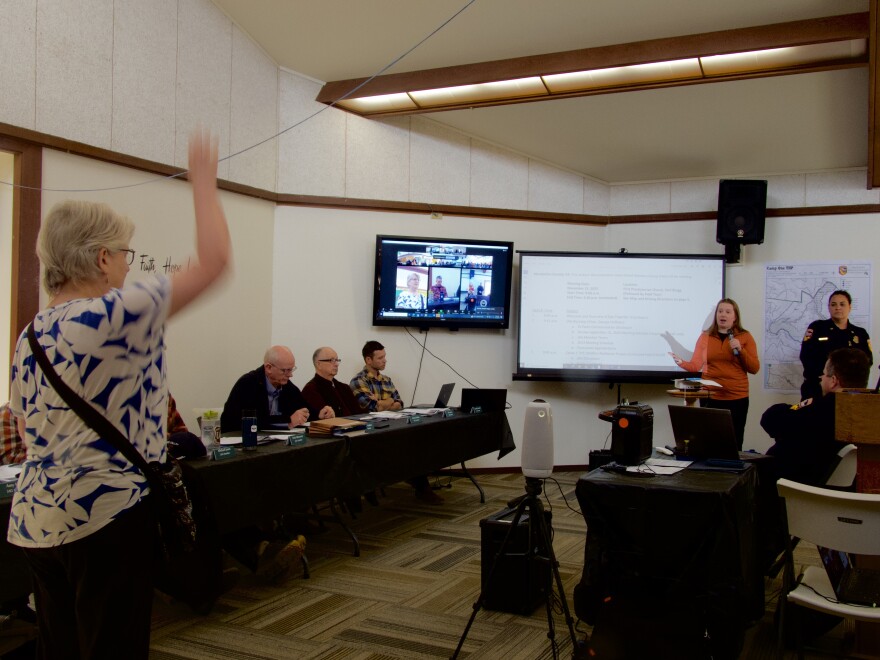The tour began seven miles out highway 20 from Highway 1, then two miles into the heart of a wilderness that has been logged for more than a century. O’Dwyer is the forester in charge of this timber harvest plan in which fire will be used both before and after the harvest to reduce fuel load. Decades of fire suppression have depreciated the forest’s natural and economic values. O'Dwyer explained that the New Vision harvest plan is supposed to slow climate change, with input from local tribes.
As we walk, O'Dwyer points out two 80 foot tall Douglas Firs side by side.One shows dead limbs and a faded canopy. The other is robust and healthy. In the old vision, O’Dwyer would have marked the weaker tree for harvesting. The healthier tree could become a truly valuable giant. But The New Vision has priorities beyond timber value: woodpeckers for one. Woodpeckers have been knocking themself senseless because there are too many solid trees full of great lumber, O Dwyer said. Woodpecker holes are a wellspring of life, giving home to insects fed on by birds and animals all the way up the food chain to bears. Wood ducks and owls can make homes inside.

So the healthier tree is now marked with a blue circle of paint, showing it is soon to be cut.
During discussion of the scary prospect of using fire in the forest, Mendocino Unit Chief Luke Kendall said it's much safer when all the resources can be set up long before the torch is set. Controlled burning is exponentially safer than using backfires to control an oncoming conflagration. Backfires have gone wrong during wildfires, but controlled burns are not the same thing at all, he said.

The JAG voted for a different“ New Vision” inspired timber harvest plan and then approved a Scope of Work for a new management plan for the forest before going out on the tour.
The meeting was a reversal of the tumultuous September JAG. This time, JAG Facilitator Emily Smith and JAG chair George Hollister imposed strict time limits; demanded speakers give their names and use the podium and microphone. This helped the JAG accomplish the entire September meeting agenda, when nothing got voted on due to general chaos.

One announcement was that Brandon Gunn, will move up from deputy chief to become Chief of the Mendocino Unit, replacing Chief Luke Kendall.

The timber harvest plan approved at the meeting was at Camp One, a popular recreation area at the Noyo River headwaters. Even environmentalists found it to have some appealing aspects. Opposition leader Bill Heil called the plan” benign” but opposes the secrecy and lack of local involvement in what he sees as a disingenuous process.
More than just the usual crowd of environmentalists objected this time.
Two JAG members voted no on the plan and one abstained. It still passed by a 5-2-1 vote but it was apparently the first time that anybody on the JAG has voted no on a timber harvest plan in its history. No timber plan has ever been given the thumbs down by the JAG, whose role is purely advisory.
Next the JAG discussed and unanimously passed its Scope of Work, which is the outline for the New JDSF Management Plan that will implement the New Vision. This was over the protests of about a dozen people who pretty much all said timber harvest plans must wait until there is actually a New Vision management plan. They say the process is backwards. Cal Fire is launching timber plans with its old vision management plan in place and calling those its new vision, the protesters said.
A main thrust of the New Vision is tribal co-management. Cal Fire has repeatedly said negotiations with a Tribal Advisory Group are going on behind closed doors. The tribes and number of tribes involved are among the secrets. Gunn described going to three different tribal headquarters and Cal Fire has provided a list of roughly 20 tribes that have been contacted.
Some protesters aren't willing to take Cal Fire at its word.
Edwina Lincoln, a Yuki woman and enrolled member of the Round Valley Indian Tribes, said Cal Fire should present a signed letter saying it's in negotiation with tribes and a resolution saying what the state’s intent is in the matter.
JAG member Joanna Nelson, who supports the confidentiality of negotiations, asked for clarity on the scope of work. She wanted to know if half of it is being hammered out in public and the other half in private, with no method established to link the two. She asked, but didn’t get an answer, whether the process includes federally recognized tribes, state recognized tribes or unrecognized tribes. All are present locally.
Protester Anna Marie Stenberg was dissatisfied by the lack of answers to questions If these two plans get underway in about two years, as is the idea she intends to protest again. When protestor Bill Heil was asked about whether he would block the harvest this time, he replied,
“We are not done with any of this yet.”
None of the veteran and mostly senior citizen protesters came to the tour in the forest but two younger, newer people who have objected to some parts of logging, did.



